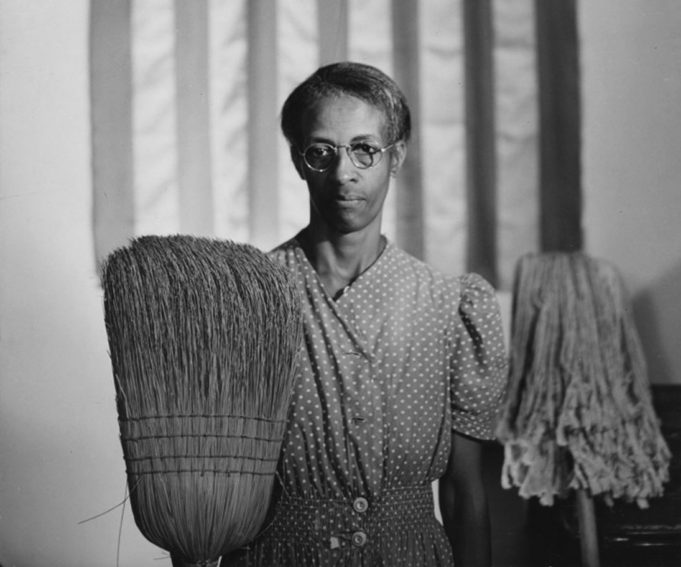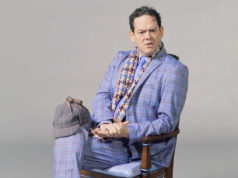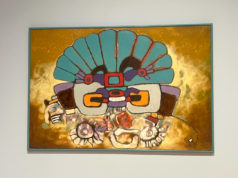Though perhaps lost on the good people at the Amon Carter Museum of American Art, here in deep red Fort Worth, one of their new exhibits is, while based in the past, painfully relevant today, offering myriad layers of subtle, contextual protest and artful statements of equality. In a society being torn apart by nativist impulses, actions, and actors, Gordon Parks: The New Tide, Early Work 1940-1950 reminds us that we still separate ourselves based on race and are not as enlightened as we may like to think.
Coined by author Richard Wright, the “new tide” in the title refers to an informal, disparate group of African-Americans, artists and street fighters alike, who were battling for respect and racial equality in the 1940s. The exhibit, organized by the National Gallery of Art with The Gordon Parks Foundation, focuses on a lesser-known though certainly formative part of Parks’ photography career, when he was elegantly straddling the chasm between journalism and fashion.
Parks is mostly known as a renaissance man of sorts, rising up from segregated small-town Kansas the youngest of his father’s 15 children to eventually devote himself to art in a variety of forms. He considered his camera his “choice of weapons,” but he had an affinity with another kind of film device: Parks was the first African-American to produce and direct major movies, including 1971’s Shaft, the over-the-top detective drama credited with spawning the blaxploitation genre. Parks, who died in 2006, also wrote a ton of books (mostly about photography), poetry, and music. Throughout all of his assorted practices, he kept his Voigtländer Brillant close. He brought the plight of poor black America into living rooms primarily via his photo essays for Ebony and LIFE. He arrived at the latter in 1949 not long after his big break, when Marva Louis, wife of heavyweight champion Joe Louis, noticed Parks’ fashion photography for a local women’s clothing store in St. Paul. Marva helped Parks find clients in Chicago, which led to his fashion spreads for Ebony and Glamour. Parks said he was as comfortable photographing Black Panthers as he was fashionable celebrities and that, at LIFE, there was “no special black man’s corner” for him.
Featuring about 150 photos, plus rare magazines, newspapers, pamphlets, and books, The New Tide shows Parks at a time when he was in the thick of a creative and intellectual flourishing among African-Americans not seen since the Harlem Renaissance. Wright, Ralph Ellison, Langston Hughes, Charles White, and Roy Stryker were among many of Parks’ subjects and, in the case of Ellison, a collaborator –– in 1952, Parks and Ellison produced “A Man Becomes Invisible,” a photo essay for LIFE based on the author’s canonical novel of the same year, Invisible Man. The magazine piece followed their 1948 project, “Harlem Is Nowhere,” a photo essay detailing the post-Depression struggle in their adopted home neighborhood. From the 1940s through the ’70s, when his time with LIFE ended, Parks homed in on poverty and social justice.
In 1941, Parks moved with his first wife and two children to Chicago, whose South Side Community Center (SSCAC) was chock full of African-American creatives and intellectuals, including Hughes, SSCAC director Peter Pollack, Alain Locke, who spearheaded the New Negro movement, and opera singer Todd Duncan. The writers, painters, poets, sculptors, and dancers who gathered around the SSCAC were part of what is now known as Chicago’s Black Renaissance. It was painter Charles White who encouraged Parks to train his lens on the streets of the nearby South Side neighborhood. They were a long way away from the glamorous society pictures through which Parks got his start in St. Paul and Chicago.
Parks’ inability to be pigeonholed offered him a lot of opportunities in the ’40s. In 1942, Parks won a prestigious fellowship, which allowed him to move to Washington, D.C., to work for the Farm Security Administration and later the Office of War Information during World War II. One of his most iconic images came from his time with the information office. Published by Ebony in 1948, his depiction of a cleaning lady is more than just a riff on Grant Wood’s famous “American Gothic.” It came not long after 300 magazines printed the American flag on their covers in celebration of Independence Day. As Old Glory hangs, a bit blurry, in the background, the woman, Ella Watson, holds the tools of her trade: a mop and a broom, with a look on her face that belies the exhaustion she must be feeling –– she scrubbed government offices at night and was the mother of several small children. As the nation relied on her support, it also prohibited her from any form of advancement. Though our country has made great progress since then, the working class today is as financially strapped as it’s ever been and the have-nots are separated from the haves mostly along racial lines.
Some of Parks’ most artful photojournalism came in early 1944, when he joined the photography project of the Standard Oil Company of New Jersey, showing lots of beautifully rendered heavy machinery and the working class, black and white, in all of their gritty glory. His work on the project resulted in one of his most memorable photos. At a cooper’s plant right outside of Pittsburgh, a young black man swings a large drum from a crane while surrounded by heavy white smoke and light. The picture could have been taken yesterday.
One of his most famous and controversial pieces for LIFE that deals with those issues is on display at the Carter, and it’s a fascinating look into early gonzo photojournalism. In the late ’40s, Parks spent a month with Leonard “Red” Jackson, the 17-year-old leader of the Midtowners gang. With the resulting 1948 photo essay, “Harlem Gang Leader,” Parks hoped to show that juvenile delinquents could be turned around with the intervention of appropriate social services. This was Parks’ first assignment for LIFE and the last to which he would surrender complete artistic control. He wrote the text for every photo essay afterward, disappointed with the tone of the story that accompanied “Harlem Gang Leader” and the choice of photos. There was too much emphasis on violence and lawlessness, Parks believed, and not enough on potential rehabilitation. Five photos from the essay hang at the Carter. While there’s a stark image of Jackson and a friend examining the face of another friend lying in a coffin, the most haunting image is of the young gang leader walking the streets alone with his back to us. Everything is so immediate –– the canyons of the buildings, the murky light, the dusky pavement –– you feel as if you’re walking right behind him.
From 1 to 5 p.m. on Sunday, October 27, the Carter will screen Shaft and offer a tour of the exhibit with local experts, the chance to participate in a vintage fashion shoot, and more. The event is free. Reservations are not required. Seating for the movie is first come, first served.
Gordon Parks: The New Tide, Early Work 1940-50
Thru Dec 29 at the Amon Carter Museum of American Art, 3501 Camp Bowie Blvd, FW. Free. 817-738-1933.












